Actual color may vary from on-screen representation.

HOW-TO
PREP LIKE A PRO
When starting a concrete project, you have to do the work before the work. That means prepping. Follow this step-by-step guide and you’ll be on your way to having a great looking floor, porch, patio, pool deck or walkway for years to come.

BEFORE YOU BEGIN: PROJECT CHECKLIST
Concrete Projects
- Cleaner/degreaser/etching solution
- Watering can
- Rubber gloves
- Stiff bristle brush
- Water hose
Wood Projects
- Valspar All-in-One Wood Prep
- 150-200-grit sandpaper and wire brush
- Stiff bristle brush
- Rags
- Water hose
Optional
- Valspar Concrete Bonding Primer
- Paintbrush
- 3/8"-1/2" nap roller cover, depending on texture of the surface
- Roller frame
- Extension pole
- Paint tray
- Stir sticks
PREVIOUSLY COATED CONCRETE
If the concrete you’re working with has an existing coating, you’ll have to do a few things before you apply new paint or stain to the surface.


STEP 1:
Test to see if the previous coating was solvent or water based. Use a rag to apply xylene to the surface. If it lifts the previous coating, then a solvent-based coating was used. If there’s no material on the rag and the surface is gummy, then a water-based coating was used.
For best results, use water-based finishes on surfaces coated with water-based products and solvent-based finishes coated with solvent- or oil-based products.
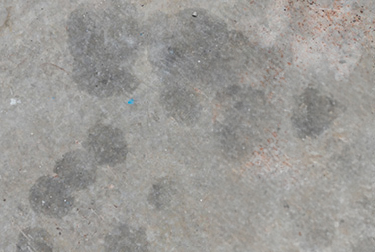

STEP 2:
Next, do a walk-around to check if there are any grease or oil stains.
1. If you have stains, apply a cleaner/degreaser/etching solution to those areas, scrub with a stiff brush and rinse with water.
2. Some stains may be a bit tough to get out, so you might need a second application and a bit more scrubbing.
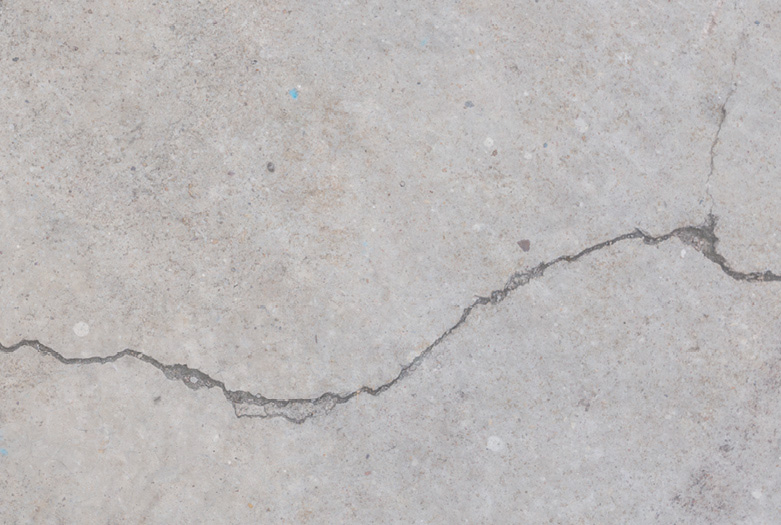

STEP 3:
After spot cleaning, look for cracks in the concrete. If you see any, use a patch and repair product to fill them in (optional).


STEP 5:
Once you make sure the surface is clean and dry, it’s time to get rolling!
NEW OR BARE CONCRETE
If you’re working with surfaces that haven’t been coated before, you still need to go through a few steps before application.
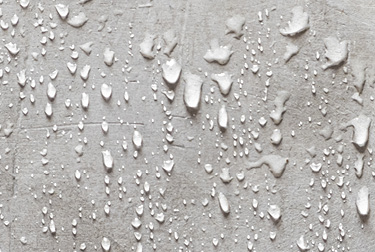

STEP 1:
First, do a water test to see how much water the surface will absorb.
1. If it’s absorbed right away, that means the concrete is porous and the coating will easily stick to the surface.
2. If it doesn’t absorb water, then the surface needs to be etched.


STEP 2:
Like previously coated concrete, you’ll need to walk around and check for grease, dirt and oil stains.
1. If you have stains, apply cleaner/degreaser/etching solution, scrub with a stiff brush and rinse with water.
2. If you’re having a hard time getting stains out, try applying a little more cleaner/degreaser/etching solution and scrub again.
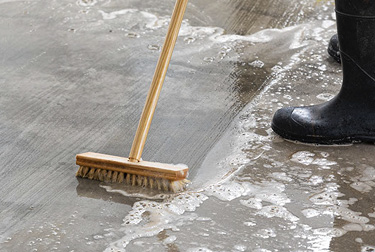

STEP 3:
If the surface isn’t water absorbent, use cleaner/degreaser/etching solution to etch it. Here’s how:
1. Wet the surface with a hose. Spread it out evenly so puddles don’t form.
2. Apply cleaner/degreaser/etching solution with a stiff bristle brush across the whole floor, then sweep the solution back and forth to make sure every part of it is covered. If it starts fizzing and bubbling, don’t worry, it’s perfectly normal.
3. When done scrubbing, rinse with water to make sure the solution and any residue are gone.
4. You may need to do this more than once to create a porous surface, but don’t give up! It’s all part of the process.
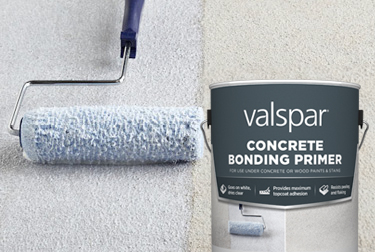

STEP 4:
Let the surface completely dry before applying the coating.
1. If you find cracks in the concrete, use a patch and repair product to fill them in.
2. If you’re looking for better adhesion to the topcoat, use Valspar Concrete Bonding Primer (optional).
3. Once the surface is clean and dry, it’s time to roll!
WOOD FLOORS
Now that you know how to prep concrete surfaces, let’s take a quick look at the steps needed to prep wood surfaces for painting or staining.
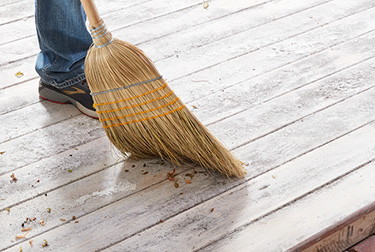

STEP 1:
Sweep the floor to get rid of dirt, peeling paint and other debris.


STEP 2:
Clean the surface with Valspar All-in-One Wood Prep to remove any leftover dirt, stains, mold or mildew. After you’ve scrubbed it, make sure to thoroughly hose down the surface to get rid of any residue. After that, simply follow the instructions on the label and you’ll be good to go.
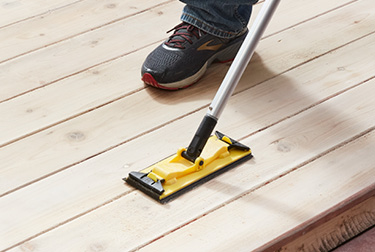

STEP 3:
If you come across rough or repaired wood surfaces, smooth them out with 120-grit sandpaper.
Warning: Removal of old paint by sanding, scraping or other means may generate dust or fumes that contain lead. Exposure to lead dust may cause brain damage or other adverse health effects, especially in children or pregnant women. Controlling exposure to lead or other hazardous substances requires the use of proper protective equipment, such as a properly fitted respirator (NIOSH approved) and proper containment and cleanup. For more information, call the National Lead Information Center at 1-800-424-LEAD (in US) or contact your local health authority.
Adequate ventilation is required when sanding or abrading the dried film. If adequate ventilation cannot be provided, wear an approved particulate respirator (NIOSH approved). Follow respirator manufacturer’s directions for respirator use.
BEFORE YOU BEGIN: PROJECT CHECKLIST
Concrete Projects
- Valspar® Fast Prep®
- Watering can
- Rubber gloves
- Stiff bristle brush
- Water hose
Wood Projects
- Valspar All-in-One Wood Prep
- 150-200-grit sandpaper and wire brush
- Stiff bristle brush
- Rags
- Water hose
Optional
- Valspar Concrete Bonding Primer
- Paintbrush
- 3/8"-1/2" nap roller cover, depending on texture of the surface
- Roller frame
- Extension pole
- Paint tray
- Stir sticks
PREVIOUSLY COATED CONCRETE
If the concrete you’re working with has an existing coating, you’ll have to do a few things before you apply new paint or stain to the surface.


STEP 1:
Test to see if the previous coating was solvent or water based. Use a rag to apply xylene to the surface. If it lifts the previous coating, then a solvent-based coating was used. If there’s no material on the rag and the surface is gummy, then a water-based coating was used.
For best results, use water-based finishes on surfaces coated with water-based products and solvent-based finishes coated with solvent- or oil-based products.
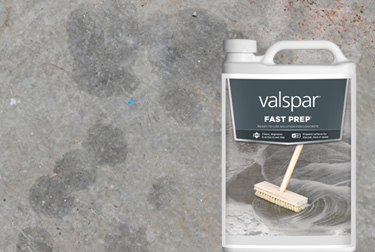

STEP 2:
Next, do a walk-around to check if there are any grease or oil stains.
1. If you have stains, apply Valspar Fast Prep Ready-to-Use Solution to those areas, scrub with a stiff brush and rinse with water.
2. Some stains may be a bit tough to get out, so you might need a second application and a bit more scrubbing.


STEP 3:
After spot cleaning, look for cracks in the concrete. If you see any, use a patch and repair product to fill them in (optional).


STEP 5:
Once you make sure the surface is clean and dry, it’s time to get rolling!
NEW OR BARE CONCRETE
If you’re working with surfaces that haven’t been coated before, you still need to go through a few steps before application.


STEP 1:
First, do a water test to see how much water the surface will absorb.
1. If it’s absorbed right away, that means the concrete is porous and the coating will easily stick to the surface.
2. If it doesn’t absorb water, then the surface needs to be etched.


STEP 2:
Like previously coated concrete, you’ll need to walk around and check for grease, dirt and oil stains.
1. If you have stains, apply Valspar Fast Prep, scrub with a stiff brush and rinse with water.
2. If you’re having a hard time getting stains out, try applying a little more Valspar Fast Prep and scrub again.


STEP 3:
If the surface isn’t water absorbent, use Valspar Fast Prep to etch it. Here’s how:
1. Wet the surface with a hose. Spread it out evenly so puddles don’t form.
2. Apply Valspar Fast Prep with a stiff bristle brush across the whole floor, then sweep the solution back and forth to make sure every part of it is covered. If it starts fizzing and bubbling, don’t worry, it’s perfectly normal.
3. When done scrubbing, rinse with water to make sure the solution and any residue are gone.
4. You may need to do this more than once tocreate a porous surface, but don’t give up! It’s all part of the process.


STEP 4:
Let the surface completely dry before applying the coating.
1. If you find cracks in the concrete, use a patch and repair product to fill them in.
2. If you’re looking for better adhesion to the topcoat, use Valspar Concrete Bonding Primer (optional).
3. Once the surface is clean and dry, it’s time to roll!
WOOD FLOORS
Now that you know how to prep concrete surfaces, let’s take a quick look at the steps needed to prep wood surfaces for painting or staining.


STEP 1:
Sweep the floor to get rid of dirt, peeling paint and other debris.


STEP 2:
Clean the surface with Valspar All-in-One Wood Prep to remove any leftover dirt, stains, mold or mildew. After you’ve scrubbed it, make sure to thoroughly hose down the surface to get rid of any residue. After that, simply follow the instructions on the label and you’ll be good to go.


STEP 3:
If you come across rough or repaired wood surfaces, smooth them out with 120-grit sandpaper.
Warning: Removal of old paint by sanding, scraping or other means may generate dust or fumes that contain lead. Exposure to lead dust may cause brain damage or other adverse health effects, especially in children or pregnant women. Controlling exposure to lead or other hazardous substances requires the use of proper protective equipment, such as a properly fitted respirator (NIOSH approved) and proper containment and cleanup. For more information, call the National Lead Information Center at 1-800-424-LEAD (in US) or contact your local health authority.
Adequate ventilation is required when sanding or abrading the dried film. If adequate ventilation cannot be provided, wear an approved particulate respirator (NIOSH approved). Follow respirator manufacturer’s directions for respirator use.

